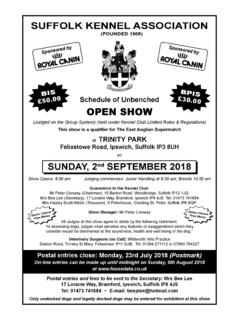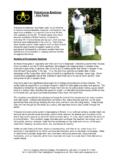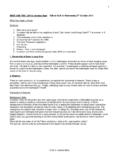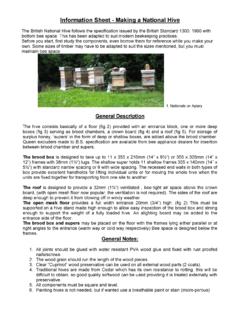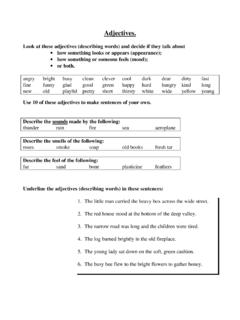Transcription of Popular Hives in the UK - The Barefoot Beekeeper
1 Popular Hives in the UKByMike 2009 Contents Intro hive Parts hive summary National - 1920's Deep National 1946 revised 1960 Top Bar hive (circa 2650 BC) Dartington - 1975 WBC 1890 Smith post 1920 Commercial 1960's Modified Dadant (MD) - 1917 Langstroth 1850 Langstroth Jumbo - 1905 Warr hive - (? - 1951) Rose hive post 2000 Which hive is the right one for me?IntroModern BeehivesHives are a convenient way of containing a colony of bees while protecting them from the elements and predators, they enable the colony to build up and maximise honey production without in any way being detrimental to the bees. Hives are made to precise measurements so all the parts within the outer shell fit properly and give a suitable space for the bees to suit the local weather conditions and climate. I have listed a lot of info here about the most common types of Hives , but from a bee's perspective it really doesn't then leaves the bee keeper with a few choices of which hive would suit them best.
2 All the Hives listed apart from the Warr and Top Bar use frames and foundation. They are managed roughly the same over the course of a season so it really doesn't matter which hive type a new bee keeper starts with but I would recommend they use the same as other bee keepers within their association and if possible start with two colonies in case one colony has a some bee keepers its not the amount of honey or the size of the colony that matters, they believe there are many problems with the conventional methods and its better to allow the bees to act as if they were in the wild creating their own brood nest instead of being given a sheet of embossed wax held in a frame. I won't go into some of the other reasons but needless to say the bees are perfectly capable of looking after their own brood nest without the need for frames or you may well hear a few times ask some bee keepers one question and will get back several different answers. If it was possible to ask a honey bee the question what would she want?
3 I like to think her answer would be this simpleSome where dry and draft proof, free from disease and all other types of pests. Plenty of pollen and nectar to gather and of course lots of warm weather so they can do what they are best at which is making honey. All modern 'framed' Hives contain the same basic parts ----Roof----Crown board ----Super----Queen Excluder----Brood chamber----Floor ----Entrance blockThe Floor or hive base is a vital piece of the hive , most floors are made from a solid sheet of wood to help contain the internal temperatures and keep the frost out, more recently with the problems of Varroa an optional open wire mesh floor could be used to help remove the unwanted mite from the hive . In addition the mesh provides ventilation which some say it allows you to keep a narrow entrance fitted all year around which is easier for the bees to defend. A good size of mesh has holes of approx 4 mm large enough to allow the Varroa to fall through but small enough to keep the hive secure from unwanted Block is fitted to reduce access to the hive during the winter time to help keep the warmth in and unwanted visitors out, during the spring and summer it can be removed when the colony is of a suitable size to defend a larger opening and thus gives the flying bee's easier access directly into the hive .
4 The entrance block should be refitted if the hive is being attacked by another colony or if the weather is poor for that time of Brood Box is the largest chamber of the hive , this is where the queen lives all year round and lays her eggs, the colony will also store pollen, nectar and honey for themselves in this chamber so its within easy reach. The maximum colony size is determined by the size of this chamber which is different depending on the type of hive . During the spring through to summer when the colony size has built up bee keepers will commonly split a colony, by removing some of the frames from the brood chamber which contain plenty of sealed brood, pollen and honey to start up a new colony in another hive nearby, then replace the frames. This is a good method to stop the colony from Queen Excluder is either a thin sheet of either steel or plastic with slots or holes cut in it. The holes are big enough to allow a female bee through but too small to allow the slightly larger queen or drone through.
5 This then allows additional chambers or supers to be placed above which will only be filled with honey as the queen is kept from laying in this area. The Super is the box of smaller frames for the bees to store excess honey, which the bee keeper will remove when its capped over and is ready to be extracted. When the weather has been favourable bee keepers will stack 2,3 or even 4 supers on top of the brood box and queen excluder. The supers are removed at the end of the season to reduce the total space of the hive to just the brood box to help the bees keep Boards is a flat sheet of wood with a hole in the centre and are used primarily as a cover on top of the brood chamber. The board creates a barrier to separate the different chambers of the hive and can be fitted with a bee escape or used to support a Roof some Hives have either a plain felt or a metal sheet covered roof, they are a good weight to stop them being blown off in strong winds and help to trap the warmth in the brood box for winter time.
6 hive Summary Conversions to metric only shown on this TypeDimensionsBrood Chamber cellsBee SpaceBrood Comb areaof both sidesFull Super Weight (Approx)No of Brood Frames (Brood Frame size)National18 1/8 x 18 1/8 460 mm x 460 mm 50000 Bottom199 sq. in25 Kgs11 (14 x 8 1/2 )356 mm x 216 mmDeep National18 1/8 x 18 1/8 460 mm x 460 mm70000 Bottom292 sq. in25 Kgs11(14 x 12 )356 mm x 305 mmDartington36 1/4 x 18 1/8 920 mm x 460 mm70000 Bottom292 sq. inNA11(14 x 12 )356 mm x 305 mmWBC19 7/8 x 19 7/8 505 mm x 505 mm45000 Bottom199 sq. in25 Kgs10(14 x 8 1/2 )356 mm x 216 mmCommercial18 5/16 x 18 5/16 465 mm x 465 mm70500 Bottom275 sq. in25 Kgs11(16 x 10 )407 mm x 254 mmLangstroth20 x 16 1/4 508 mm x 413 mm61400 Top272 sq. in30 Kgs10(17 5/8 x 9 1/2 ) 448 mm x 241 mmSmith16 3/8 x 18 1/4 416 mm x 463 mm50000 Top199 sq. in25 Kgs11(14 x 8 1/2 )356 mm x 216 mmTop Bar36 to 48 x 16 to 19 914mm to 1219 mm x 407 mm to 482 mmVariesBottomVariesNANA(varies per hive )Rose18 1/8 x 18 1/8 460mm x 460mm35000 Bottom175 sq.
7 In30 Kgs11(national frame cut down)Dadant&Langstroth Jumbo20 x 16 1/4 508 mm x 413 mm85000 Top340 sq. in40 Kgs11(17 5/8 x 11 1/4 )448 mm x 286 mmHivesThe National Hive1920'sThe National hive is the most Popular hive in the uk because of this it makes life easier for bee keepers to buy colonies on frames or exchange equipment with other bee keepers. Although some Bee Keepers think the national brood box is too small for a prolific queen. The supers are the smallest of all Hives and so the weight of a full super is the lightest of all Hives FramesThe standard brood body is 8 7/8 deep and takes 11 frames. The most Popular brood frames are the DN4 and the DN5. Both have the Hoffman side bars, which means the side bar is wider at the top and narrows towards the bottom. The DN5 has a wider and stronger top bar than the DN4. These frames are favoured because they are self-spacing and do not require any extra equipment to keep them the correct distances apart.
8 The bevelled edges at the top of the side bar allow the bee keeper to see clearly when pushing the frames together to help avoid any bee's getting trapped and killed between the frames. Additionally there is a smaller contact surface area between the frames for the bees to glue together with complete hive comprises: standard floor, brood body with eleven brood frames, a queen excluder, a super with ten super frames, a crown board and a metal sheet metal covered 4" roof. Most National Hives are made from Cedar, which do not require any preservatives as cedar has its own "camphor" type preserving oils. This natural oil protects it from the weather and discourages insects. Cedar wood is an ideal timber for Hives in the British climate and will last over 15 years naturally so there is no need to paint the hive as this would seal up the grain which will cause mould and condensation problems on the inside. How many frames in each box11 Hoffman (self-spacing) frames in either a brood body or super.
9 Although it is possible to fit in 12 frames, it is easier for manipulation to use 11 frames and a dummy board. 11 frames on narrow ends in the brood body10 Manley frames in the super9 or 10 frames on castellated spacers in the super8 frames on wide ends in the superSummaryThis is an excellent hive for all bee keepers as it is a reasonable size, easy to manage and transport. The colony size needs to be carefully monitored during the early spring as a strong colony build up or if the queen has no-where to lay (honey bound) will lead to swarming problems early in the Deep National Hive1946 revised in 1960 The Deep National hive is becoming a very Popular hive in the uk . Some Bee Keepers have either modified their National Hives into a Deep National or they have bought a replacement Deep National brood body to allow for the prolific queens. The supers are the smallest of all Hives and so the weight of a full super is the lightest of all Hives . The Deep National hive is the same size as the National hive apart from the depth of the brood chamber which allows for deeper frames to be used.
10 The 14 x12 frame greatly increases the total number of cells per frame for the queen to lay in and also for the colony to store greater amounts of pollen and nectar for the deep national hive are called 14 x 12 frames for super are the same as in the National hive . I modified the above National hive with a home made 90mm eke to allow the use of 14 x 12 frames in the brood is an excellent hive for all bee keepers as it is a good size, easy to manage and transport. Once modified to fit the 14 x 12 frames the colony during the spring build up has more space to expand into which will delay a colony from swarming very early into the season and it is very unlikely the queen will become honey bound. National & Deep NationalSince these Hives are now the most common in the uk for their ease of transferring equipment between bee keepers and the fact commercial sellers of nuc's, packages and queens now also use this hive as it has simplified many of the problems bee keepers face.
